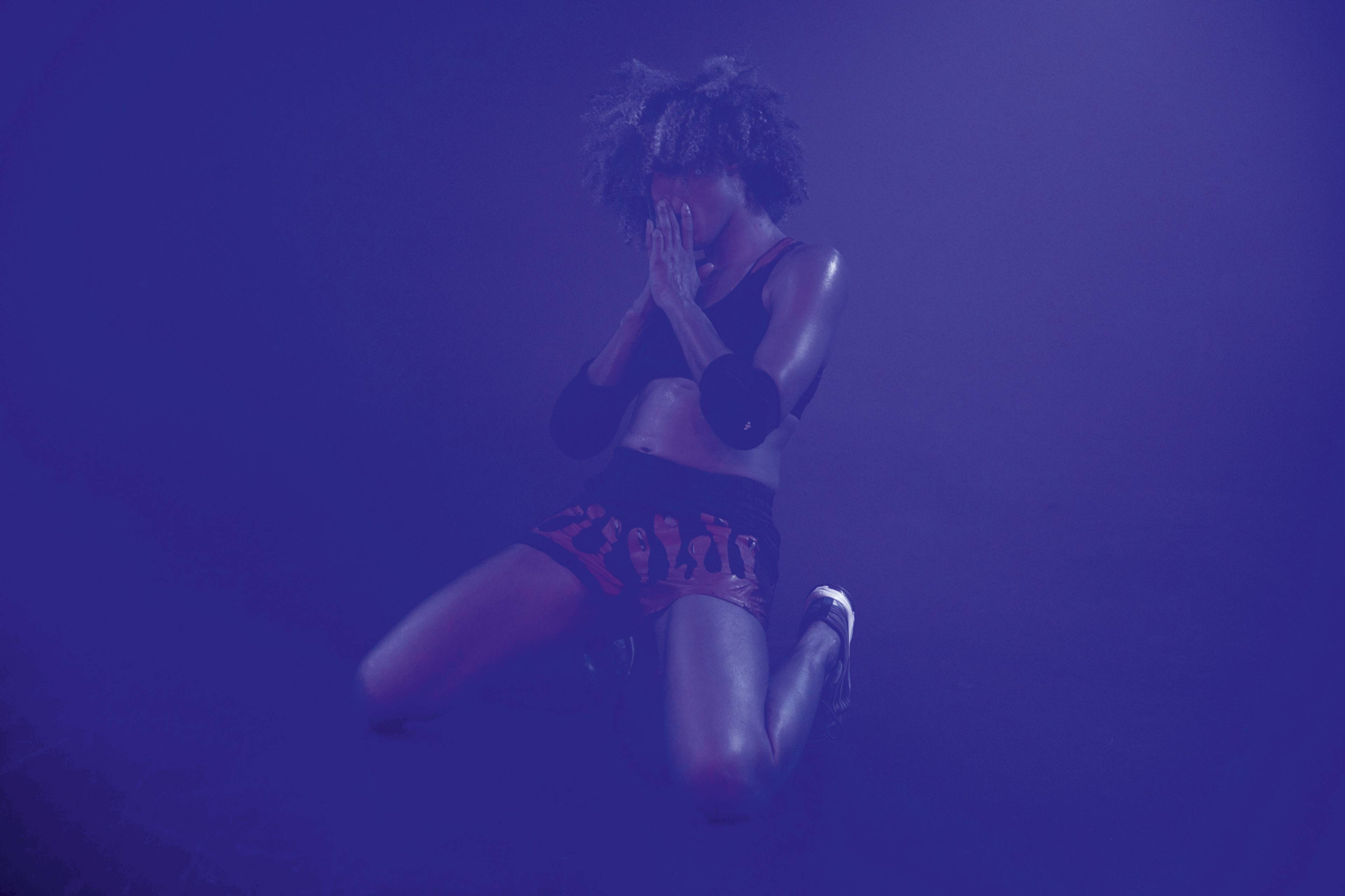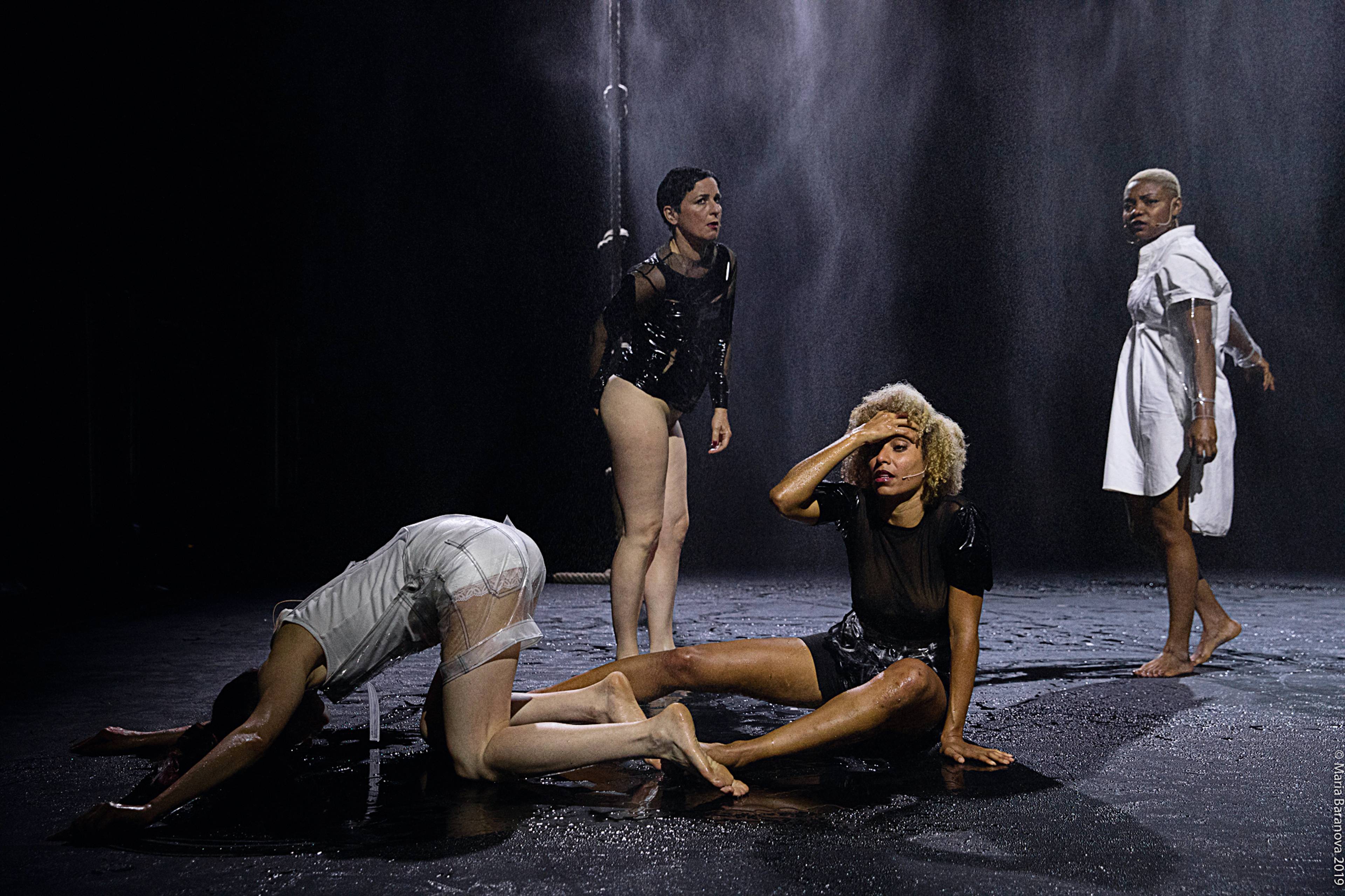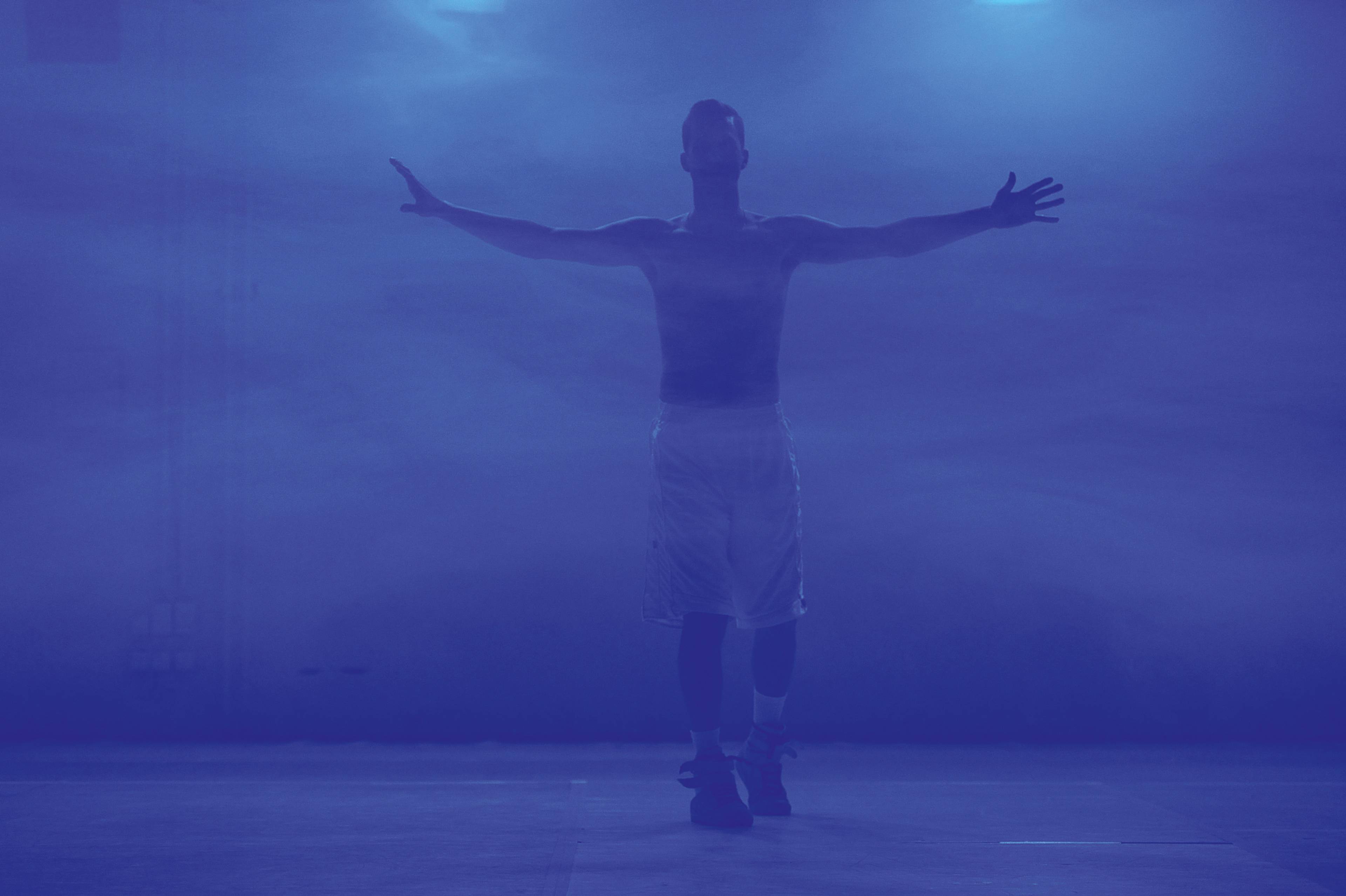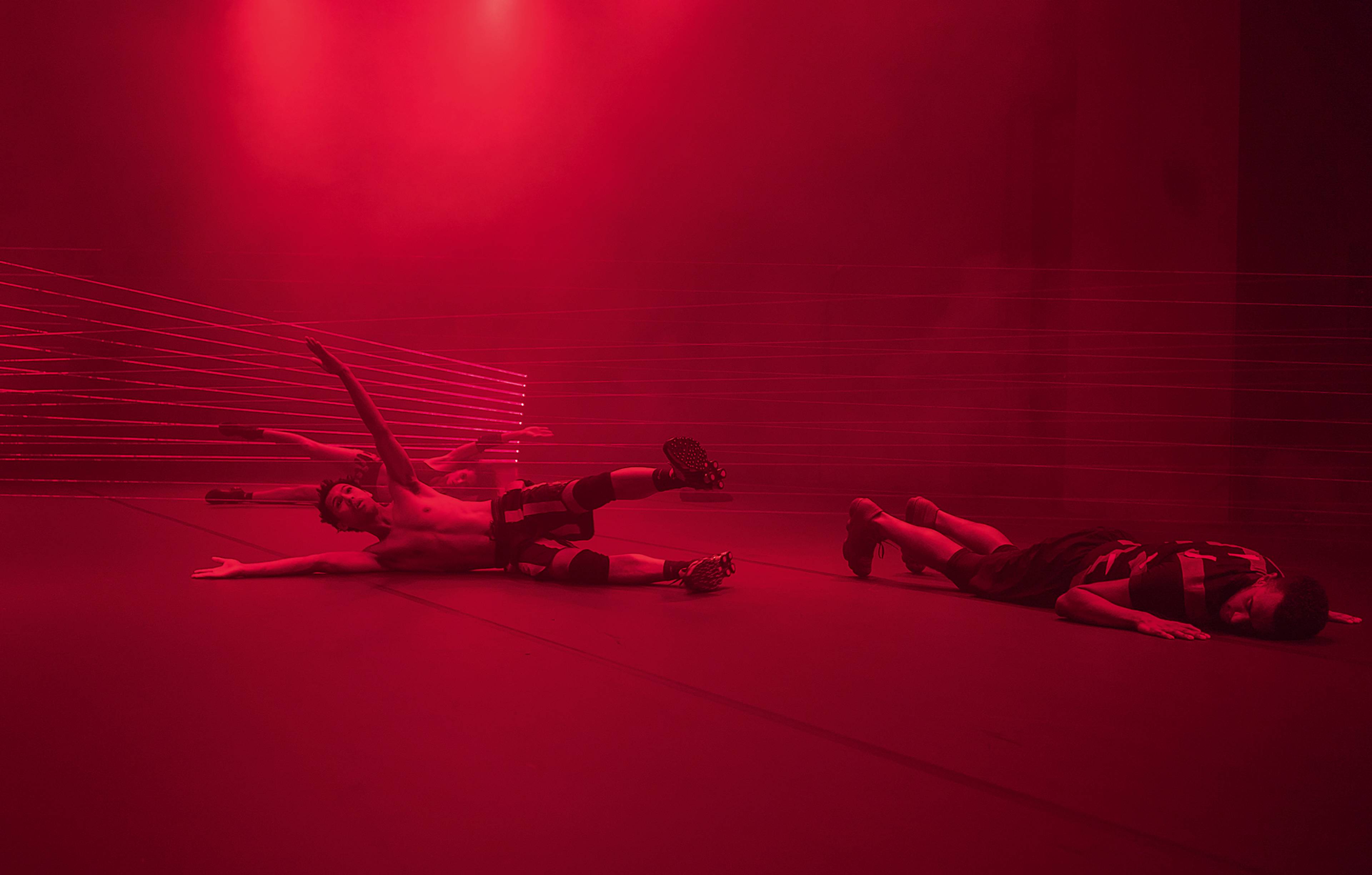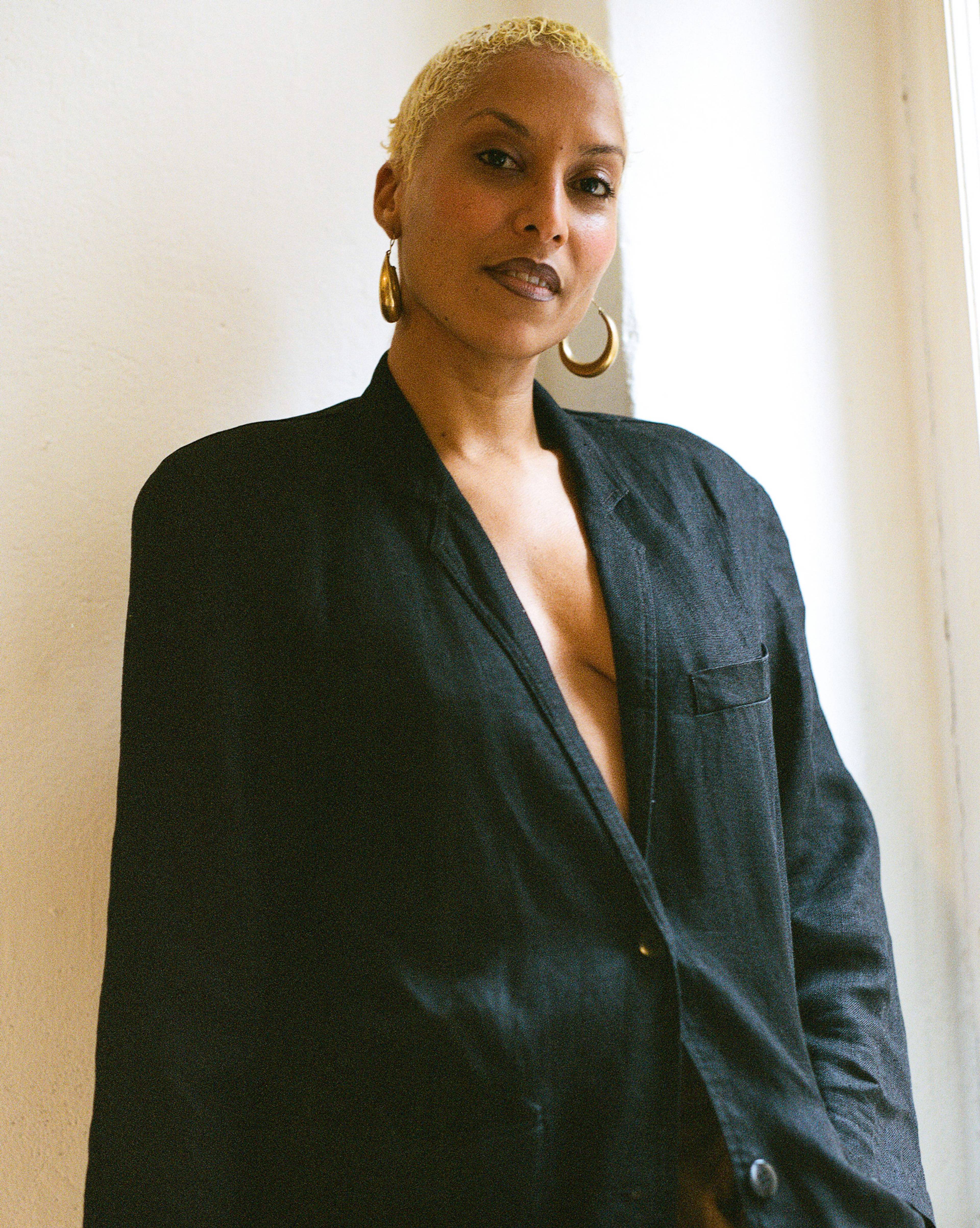Tavia Nyong’o: Let’s start with one of your pieces that made a great impression on me as an audience member, minor matter (2016). I saw it twice, in New York and Los Angeles, and the dynamic interplay between you, Jonathan Gonzalez, and Thami Manekehla held a power that lingered at the molecular level long afterwards. The breakdown of balletic virtuosity, gumboot and step show, and contact improvisation made the strongest possible statement, I felt at the time and still do, that what couldn’t quite be put into words needed to be worked out on the dance floor. Placing it now in the context of Sorrow Swag (2014), the solo that launched the trilogy and Water Will (in Melody) (2018), the piece that completed it, I want to ask about the place of “the Athletic” across that trilogy: I’m thinking about the ways in which sports attire, sports bras, shorts, trainers, jock straps, and knee pads are part of what you and your dancers often perform with, and also about that grappling sequence early on in minor matter that then became a kind of recurring motif. How did you become interested in sports and athletics as a compositional element? Were you yourself an athlete?
Ligia Lewis: My entryway into physicality was via athletics. I ran track and field, and I was a fairly committed basketball player, joining my twin brother on a team. I grew up being obsessed with Michael Jordan, like most people in my generation, I guess. I only arrived at dance later, at sixteen, simply because I wanted to go to a different high school. Dance was kind of secondary, it wasn’t an immediate desire. But sports and its physicality were something that I never let go of. That’s something that stays in the body, despite the fact that with dance training, you’re kind of forced into another relationship to embodiment, one that is often predetermined or prescribed through tradition. I went through that training as well. When I first developed my own practice, my body inevitably went back to things that it intimately knew; it also created a way for me to resist a certain hegemony of the body present in my early dance education.
With athletics, there’s something popular about it that I’m still attracted to. Also, as a Black femme, the queering of embodiment feels inherent to every action, so in a way I could fully embody my athletic form without an overt consideration of “gender”. In the making of both Sorrow Swag and minor matter, the figures felt close to me. In Water Will as well, although I’m exploring something formally entirely different: mime, minstrelsy, and a kind of plasticity of the body. The later work is much more theatrical and deals with seeing and being seen within the scene of the theatre, a slight nod to Brecht, although I was trying to rethink theatrical melodrama. So each work is attending to the body in very different ways and to the space in which the actions unfold. I never create pieces without these considerations which include light and sound. This is really important because I really cannot stand the fetishism that surrounds the body both historically and presently, particularly for racialised bodies. Dressing each dance with a considered music score and within a visual design allows me to work through physical narration to build a dynamic dramaturgy that releases itself from the fetish of the body and the fetish of movement invention. I’m always after something specific in my work, even while experimenting.
To go back to minor matter and sports, wrestling was a really important metaphor for me. Wrestling with one another, and also with the black box itself, wrestling within and against representation. Also, a playfulness emerges out of these physical gestures, as does a kind of erotics of the flesh, Black flesh, which destabilise representations of the body that are so solidified within a Western canon. I am inspired by the way in which feminist critic Hortense Spillers is reflecting on the flesh. Sweat, and all the things that come with these kinds of more forceful entanglements, are things I’m still busy with.
Ligia Lewis, minor matter, HAU (Hebbel am Ufer), Berlin, 2016. Courtesy: the artist. Photo: Martha Glenn
Ligia Lewis, minor matter, HAU (Hebbel am Ufer), Berlin, 2016. Courtesy: the artist. Photo: Martha Glenn
TN: Picking up on this idea of the erotics of the flesh, there is this clear sense that I get from your work, again with the trilogy, of quite direct gender play. You cast a male-presenting dancer as Antigone, and in that moment of wrestling, you have a dancer perform bits one-on-one and sort of inflecting athletic virtuosity through an unexpected reversal of masculine and feminine. But since you bring up Spillers, for her there is this powerful sense in which the racialised Black body is, upon some readings, always queer. There’s no way to present a Black performance not to be read as perverse according to the norms of Western gender. It seems like sports is one of those particular places where this contradiction is exposed. Is that part of what attracts you to it?
LL: Absolutely. This whole idea of gender construction feels imposed by a Eurocentric lens. I only use the term “gender” when it’s inflicted on the white male performer in Sorrow Swag. I was like, that is y’all’s thing, y’all need to work that out, because we don’t do that. But inside that piece, Brian Getnick is asked to wrestle with that inscription in attempts to escape it as well. I loved that when I performed inside of that work and in minor matter, and Water Will no one talked about gender. I think that speaks in part to how race, bodies, embodiment and flesh are understood.
What happens when your own desires exceed most political claims?
TN: In Water Will, there definitely seems to be an interest in – you used the phrase, in one of your interviews – “fugitive choreography”. There are multiple meanings in which one could take that. I take it to be that your work is partly presenting but also partly withdrawing the body from view, literally. Like into the mist, into the whale, the voice in the darkness. So evading capture by representation. But are there other senses in which you were thinking about the fugitive feminine, either in that piece or in the trilogy?
LL: I’m always searching for or attempting to create the conditions from which an excess of flesh can just be. I’m so conscious of the framework of the theatre, and as of late, thinking also about the lens of the camera.
I’m so conscious of what perspective does in general and what optics do, especially for racialised subjects. Like, that container is not not violent, also similar to the Museum. There are prescribed logics that don’t just disappear because I want them to. So I have to wrestle with many things, to work through some of what I think is required for that zero degree of the flesh to just exist, just be, in peace – free from co-optation and productivity in racial capitalism. This forces me to work often in indirect ways, around and through lots of different material, so these moments come as a surprise or are unexpected. Considering the context I’m in, I work through multiple histories, embodiments, and performative modes. I try to produce the conditions from which even just a moment of the force of the flesh could be felt, at times in the dark spaces in my work, or in and through the saturation of image and action, or when representation itself falls apart. These moments are fleeting, they are on the run. And in a way I am on the run from my own knowing as well, which is why experimentation is so important to me.
Ligia Lewis, minor matter, HAU (Hebbel am Ufer), Berlin, 2016. Courtesy: the artist. Photo: Martha Glenn
Ligia Lewis, Sorrow Swag, Tanznacht Berlin, 2016. Courtesy: the artist. Photo: Dieter Hartwig
TN: Here we are a year into the pandemic, an interregnum in which the theatre as we know it has seemingly collapsed. From where I sit in New York, there has been this tragic dereliction on the part of institutions to protect the lives and livelihoods of artists and arts workers. Ironically, film and TV have done better, because they have deeper pockets and a bigger audience. But there remains this very specific need to reimagine performance art, theatre and dance for the camera in new ways for this specific conjuncture. When I watch a piece like deader than dead, I’m wondering, are you thinking of this as dance documentation still? What does performing for the camera mean in a moment in which the future of live performance is clearly in flux?
LL: Nothing replaces the live experience of bodies wrestling with themselves and with the space that they’re in and with the material that’s been given to them. But deader than dead is definitely more than a document because the edits are very deliberate. I cut down a piece that’s otherwise an hour and twenty minutes to twenty minutes. It’s also multi-screen. Its presentation is trying to do something more than just what a document does. It’s trying to hold onto a part of the essence of the performance, which can never be reproduced but inevitably can exist parallel to it. The energy that I’m interested in with live performance, the kind of chaos that I’m seduced by, is the messiness, or its wildness to borrow a term that you use. And the excess of the flesh, its spilling out of the frame, its inability to be contained, which is present inside of minor matter and the rest of the trilogy as well as in deader than dead. Switching from the frame of the theatre or gallery space, to the frame of the camera didn’t feel like such a jump. What I appreciate about the camera lens is that then it’s much more intimate. I’m also seduced by the possibility of moving from the romance of ephemera and live performance to other formats. I’m happy with deader than dead in particular having shifted it over to video. You’re right about the conditions for dance in the theatre and in visual arts contexts, the conditions either barely exist or are fragile. Let’s see if TV would ever venture into such experiments.
minor matter, HAU (Hebbel am Ufer), Berlin, 2017, with Tiran Willemse, Jonathan Gonzalez, and Ligia Lewis. Courtesy: Ligia Lewis. Photo: Martha Glenn
TN: One of the first performances I saw in 2012 was Lewis Forever, which did feature a camera, correct? Was there not also a live feed in that show?
LL: There was a live feed and there was an imposter that came in to play me because I was not there in person for the shows. I appeared later through video. [Laughter]
TN: And then that became the film, A Guide to Kinship and Maybe Magic (2012).
LL: That became a film, exactly. That was intense. [laughter] I mean, family … We love each other but it’s hard to work with family. I’ve worked with my twin brother twice. He scored Sorrow Swag and he scored a project I did on the High Line in New York. We inevitably collaborate still but it’s always better to just have one director in a room or else it’s a real chaos. However, a lot was learned from that process.
I’m always wrestling with the history of white violence. Always. I can’t escape it.
The Movement for Black Lives is huge. It heightens the necessity to re-articulate the relationship between art and politics which is a given for Black artists. In a way, this movement forced me to become a little bit more precise in what I was after, in a sense, to become more aware of what’s at stake, which is a lot. I don’t reproduce protests, or try to represent them, or even make a direct correlation between my pieces and this movement. I work in aesthetics and in dance and choreography, often in “white spaces” so I have to be honest about the limits of what I do as well as the limitations of these spaces. But can my work, when articulated at its best, invite the desire to act in a way to resist a passive engagement with the racial violence that surrounds us, even in the most subtle of ways?
Still from Ligia Lewis, deader than dead, Hammer Museum Los Angeles, 2020. Courtesy: the artist
Protest has been and will continue to be incredibly important, and it’s a pity right now that this pandemic has inhibited more forms of gathering. But I do think we are again entering into an era of protest and deep polit¬ical reflection and action. That spirit will carry some things forward. But also, what happens when your own desires exceed most political claims? That’s why in my work, I create through my imagination and through fiction, often through an anti-realist lens.
I really do believe just the spirit of being able to be fleshly and in the present gets so quickly replaced by things that are considered more civil, more productive. That blows my mind. I want to antagonise this fact, this problem. For example, this universal logic, that’s overly pronounced here in Europe which of course works well in conjunction with the essentialising and exotifying of the “other”, and the performance of white liberal colour blindness, this we all know is the farce that enables this perverse universalism, which is always exclusionary by nature and by law. Which is in a way to say, Black Lives Matter as a statement alone, uttered by non-Black people, is and never will be enough.
I want to release myself from the pressures to create something productive for a future narrative in racial capitalism.
TN: This expression of performative allyship comes to mind when we think about speaking words for the very first time, as if there hasn’t been a deep history that you evoke. Words are important in your works, whether they are stuck in the throat of a rasping body, or converted to the tragicomic gestures of the mime. Watching your pieces of the past decade or so here in quarantine, it’s hard not to feel like certain moments, certain gestures, anticipated the horrors that were to come. But if they did, it was only because those horrors have never really gone away. Maybe to borrow a phrase that you use, your choreography “corpses history”: it doesn’t simply transmit history or communicate it, but renders it vibratory in the space of performance, through the minor matter of vocal cords, quivering flesh, sweat, and heat. I wonder whether you think that’s an accurate account of what you’re attempting to do? What is the relationship of these gestures to historical trauma, but also to present and ongoing trauma?
LL: I’m always wrestling with the history of white violence. Always. I can’t escape it. But it doesn’t mean I don’t find spaces, cracks, for something else. I do think the frame is pre¬cisely the space to work some of this out, which is to say that I would probably never use the term “healing” in relationship to my practice. There is no proper space for healing so long as these racial logics that saturate the present continue. I feel like I’m just here sharpening my tools. What I mean by that is, not to leave the trauma and violence for the past because these are recurring and there’s nothing that’s been put in place to stop it. There’s nothing that is in place that could secure Black life.
So now I want to try to find a way in which I can create something, potentially not so meaningful, absurdist even, that doesn’t fall into the traps of historical reason and the fallacies of progress, or doesn’t get instrumentalised as a kind of example of Black uplift or inclusion. I want to totally release myself from the pressures to create something that might be productive of a future narrative in racial capitalism. That’s why, in part, many of my pieces corpse themselves as they move in and through dystopia.
Speaking to corpsing history, the challenge is that history is how canons are built. Maybe I can corpse that and create something totally absurd, nonsensical, wild, strange that’s totally unproductive. This next piece, Still Not StilI, is kind of a meditation on killing off of historical reason, where I began with deader than dead. This recurring theme of dying that unfolds in this strange, strange world. Still images, and image making along with falling and dying are motifs inside of this landscape saturated in colours reminiscent of sunsets and desert skies and at moments playing with overexposure. I have this village of folks, once again another beautiful ensemble, that grapple with trying to get out of this cycle of the past, or of history. Power is shifting constantly across the group. This piece builds up to a monumental moment beautifully performed by Jolie Ngemi. It’s a moment where everyone dies. It’s the most celebratory moment. She dances on everyone’s graves, but she’s also all alone now. She has no one to play with. She’s lonely. With this piece I guess I’m grappling with my own dystopian fantasy of the end of the world, just in a very literal, silly way, but also even knowing then that the very things that made this one probably persist. So I guess I’m thinking how to create something that steps entirely to the side of power?
TN: While it’s clearly frustrating to have to accept the European theatre as a predominantly white space, I wonder if it’s also potentially liberating, insofar as it can then become a site of its own unworking. I’m thinking now about how Black dance gets to sidestep historical reason, precisely because our dance has been so “unreasonable.” And I’m reaching you in Germany, my mind goes to Hegel’s and his noxious idea that Black people don’t have a history. What would it mean not to get defensive and respond “no, we have a history and a canon just like you,” but to instead refuse to take the bait and ask, “what’s so important about history on these terms?” What if Blackness can go about the undoing of the kind of history that the Hegelian framework of reason – and its violent coloniality – relies on? This is what makes thinkers like Denise Ferreira da Silva and Fred Moten so exciting to me, because they’re in that wild space, wandering outside historical rationality without directly trying to replace it or repair it. The ruse of representation is thinking that we’ll ever compensate for the lack it finds in us by filling in the gaps and propping dead and decaying institutions up.
LL: Absolutely. The question is, and this is something my friend, artist and scholar Mlondi Zondi said, “What happens if we were to recuperate nothing?” He uttered this once to me, sharing part of his thinking and practice. I loved it and it stuck with me. So it’s not to say that we don’t experience these subtle moments of possibility in the everyday and the nuances of other histories getting made. It’s just to say that somehow, some way, what we have set up now structurally doesn’t permit for those things to have the life they deserve. That’s the thing. It’s not total doomsday, but I do like to think what are we all willing to give up? And what if it’s everything?
Ligia Lewis, 2021. Photo: Luis Rodriguez
___
“Complaint, A Lyric”
Hebbel am Ufer, Berlin
15 – 19 Nov 2023




